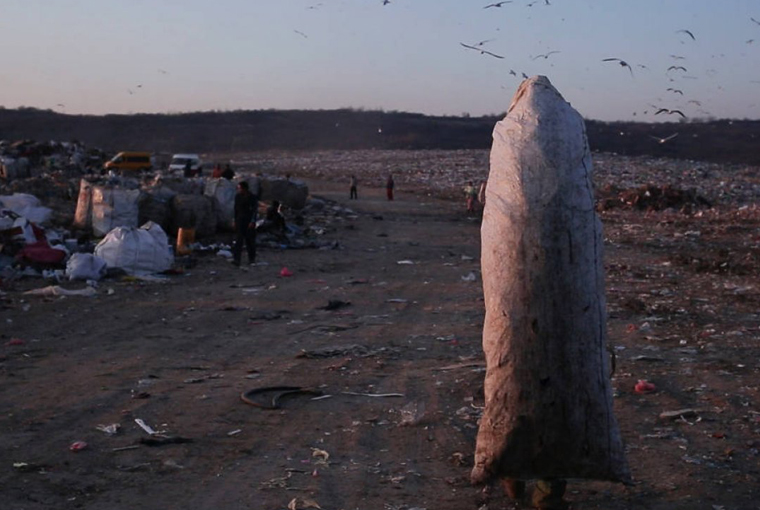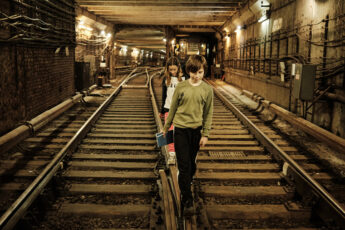“Bottlemen Are Gone, We Disappeared Like Dinosaurs. Time to Go Home.”
Nemanja Vojinović’s Bottlemen (Flašaroši, 2023)
Vol. 141 (January 2024) by Jack Page
In Vinča – an age-old, suburban settlement near Belgrade – lies the world’s second-most polluted landfill. In a bid to prevent the ever-increasing air pollution and reduce the harmful emissions that bleed into the neighboring city, the council vows to construct a waste management site at the junkyard. Although the endeavor seeks to improve the lives of the citizens, the plan poses a threat to the livelihood of a handful of hardworking people: the “bottlemen”. This name is given to the team of young Roma men who salvage all the plastic bottles at the dump. The documentary follows the leader of the pack, Yani Boc, and his plight as his so-called colleagues and competitors perform their playground politics and attempt to usurp his good-natured leadership for a step up on the employment ladder. Often testing each other’s masculinity by questioning their ability to provide work and income, Yani is one of the few “bottlemen” who play by the rules and put their family first.
Although the documentary is segmented into three main chapters, the film spends plenty of screen time away from the landfill following the Boc family. As Yani’s story progresses, Bottlemen becomes a deeply personal study as we witness his struggles with illiteracy, his father’s death, and his striving to pay alimony for his daughter. Suspended from his job for six months for a late delivery, Yani visits his family’s farmhouse tucked away in the small hometown of Novi Becej. His father explains that a relative continues to steal from them and that the corrupt police refuse to protect them as they have been bribed with brandy. The interior of the living room is in disrepair, with doors hanging off hinges and windows fractured. At the stable, a veterinarian examines one of the horses they breed. The animal is collapsed on the ground, its ribs protruding through its emaciated frame, lacking the energy to properly raise its head. In these somber and upsetting moments, it is clear that Yani’s worries and responsibilities stretch far beyond that of the junkyard as he pledges to fix the farmhouse.
Back at work, Yani’s team is comprised of adolescent delinquents who drunkenly play truth or dare in their underwear after their shift at the landfill. Just eight hundred meters from the site, Yani allows his group of “bottlemen” to lodge with him for free in his bedsit. In the messy house-share, his generosity is soon abused by their selfish behavior. Yani’s team lean into the social aspect of their job, partying until late and waking up hungover, reluctant to go to work. Yani even trains a newcomer named Slavisa who eventually usurps him and replaces him as group leader of the “bottlemen”. Deserted by his partners and weary of the territorial pressures of the job, Yani sits alone amongst the trash. A close-up lingers on his solitary frame, hunched up against the refuse, surrounded by objects that – just like him – were discarded, mistreated and forgotten.
As the very first scene of the film illustrates, the life of the “bottlemen” is a hazardous one. When the landfill catches fire, the team work with the fire brigade to hose the flames out. Dressed in just T-shirts and shorts, they brave the hellish zones that sizzle and crack. The garbage produces waves of black smoke as the landfill is covered with a layer of ash. The accompanying soundtrack of drums adds an appropriately military tone to the undertaking. It is a wonderfully engaging scene that captures the primordial nature of the job and the fortitude required by the men who must harvest the bottles to make a living.
Ironically, despite the documentary’s subject matter, Bottlemen has a very handsome aesthetic. Informed by the epic scale of the cinematography – in the extreme long shots, the surface of the dumping ground stretches on forever –, the distinctive imagery is unlike any other. Its vibrant collage of garbage displays a vast spectrum of unexpected colors, simultaneously grotesque yet mesmerizing. Like the surface of another planet, the environment appears dangerous and uninhabitable. The shots of cascading rubble and debris echo the appearance of its natural opposite: the crumbling of rock from a mountain or snow during an avalanche. The constant frenzy of screeching gulls and beeping machines is tortuous at times, but further serves to build upon the landfill’s inhospitable setting. The camera angles cleverly frame the colossal machines with their whirring engines, turbines and chains. Some vehicles cut through the rubbish like a ship floating upon the ocean, while others tear a pathway like something out of this world. In comparison, the minuscule workers dig for plastic bottles, dodging the sweeping barriers and crushing tailgates of the trucks. The electronic hum of the soundtrack, with its synthetic keyboard notes, make these huge, industrial mechanisms reminiscent of spaceships given their monumental size and robotic movements. Through its dynamic cinematography, what could have been an innocuous and dull location, is cunningly transformed into someplace strange, formidable and – at times – beautiful.




Leave a Comment